No Wire Hangers
Posted by denisefisher on April 29, 2009
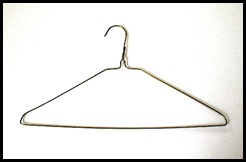 Hangers are ok to use for displaying clothes, but they’re among my least favorite options for storing clothing. It’s not just wire hangers; it’s any kind of hangers. I don’t have anything against them, it’s just that when I’m changing clothes, I don’t feel like hanging something up. I’m more of a “chair draper” than a “clothing hanger,” though I don’t mind hanging a sweater on a doorknob or even on a coat tree.
Hangers are ok to use for displaying clothes, but they’re among my least favorite options for storing clothing. It’s not just wire hangers; it’s any kind of hangers. I don’t have anything against them, it’s just that when I’m changing clothes, I don’t feel like hanging something up. I’m more of a “chair draper” than a “clothing hanger,” though I don’t mind hanging a sweater on a doorknob or even on a coat tree. 
The point of all this is not to tell you that I’m too lazy to hang up my clothes. It’s to remind you that your wardrobe storage system needs to be functional for you – not just to look good for a magazine photo. If it’s not convenient for you to use, you just won’t use it. The problem isn’t that you’re not complying with the design of a particular storage system, it’s that the storage system needs to reflect your personal style for putting things away.
Astute parents know that if they want their children to put things away, there needs to be a designated place for things to go, and it needs to be easy to put them there (and to get them back out). What’s good for children, turns out to be a good design for adults too.
Before the invention of the hanger (various versions were patented between 1869 and 1920), there were no closets for hanging clothes. 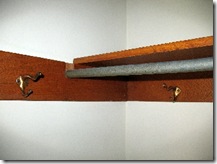 If you’ve ever been through an original house built before 1920, you won’t find any clothes racks, and possibly not even a designated storage space for storing garments (that’s what wooden wardrobes were designed to do). Obviously, people owned fewer garments in those times, but for the few garments that weren’t folded (including coats) there were pegs or hooks for storing them. Before there were hangers, there was no need for hanger rods.
If you’ve ever been through an original house built before 1920, you won’t find any clothes racks, and possibly not even a designated storage space for storing garments (that’s what wooden wardrobes were designed to do). Obviously, people owned fewer garments in those times, but for the few garments that weren’t folded (including coats) there were pegs or hooks for storing them. Before there were hangers, there was no need for hanger rods.
Pegs or hooks are still the coat-hanging devices of choice for kids’ coats at school. Backs of chairs also seem to attract jackets and sweaters at my house. While they may not be ideal for storing fine clothing that is infrequently worn, hooks are terrific for outer garments and clothing items that go on and off several times throughout the week. Coat trees, rows of hooks near a doorway, and single hooks on the backs of door provide situational options of the hook theme. I am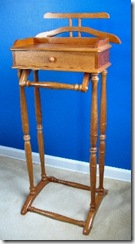 also a big fan of using a valet (the more elegant alternative to the back-of-a-chair option), especially for laying out the next day’s outfit to wear. Using a valet has the added benefit of creating a sense of dignity and importance to one’s clothing selection and their appearance, in general. It evokes that same sense of confidence that comes from donning a special interview outfit, and extends it to your daily dressing routine.
also a big fan of using a valet (the more elegant alternative to the back-of-a-chair option), especially for laying out the next day’s outfit to wear. Using a valet has the added benefit of creating a sense of dignity and importance to one’s clothing selection and their appearance, in general. It evokes that same sense of confidence that comes from donning a special interview outfit, and extends it to your daily dressing routine.
Folding clothes to store in drawers or on shelves is another alternative to hanging clothes from a rack, but it only works well for putting clothes away. If clothes are folded and stacked in a drawer, you can only see the items on top. Folded stacks on a shelf improves the view, but still results in difficulties if you try to pull out something from further down the stack (and don’t even think about trying to replace an item back in the stack where you found it).
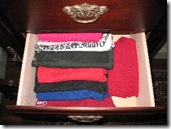 The folded clothes solution that I find most effective is to reduce the height of the stacks. On a shelf, three is an acceptable stacking height, but if you can have a separate divider shelf between each garment, that would be the best. In a drawer, I use a fanned stacking method. It allows for full visibility, and a fair means of accessibility and replacement, even if you can’t store as many items per drawer.
The folded clothes solution that I find most effective is to reduce the height of the stacks. On a shelf, three is an acceptable stacking height, but if you can have a separate divider shelf between each garment, that would be the best. In a drawer, I use a fanned stacking method. It allows for full visibility, and a fair means of accessibility and replacement, even if you can’t store as many items per drawer.
While I’m on the topic of clothing storage, let me remind you to beware the allure of novelty storage units and organizing devices. They look very cool in the catalogs (though if you look observantly, you’ll notice that they are demonstrated with a minimal amount of items in them, and the sellers seem to select items that will fit the organizers, rather than designing the organizers around the items to be stored). If you really think a storage system will work for you, try out a prototype first. Instead of buying a set of plastic sock dividers, cut up cardboard tissue boxes (or whatever replicates the design of the manufactured item), and try out your makeshift prototype for a while to see if it really works as well as you imagined. If an organizing device is well designed and functional, and it actually helps you keep things organized, it could be worth the money. But if you buy it because you think it will motivate you to get things organized and maintain order, but it clashes with your personal style, you’re risking a waste of your money with the potential purchase of a white elephant.
If you are up to the ultimate challenge of wardrobe organization (or even if you just aspire to meet it someday), try designating part of your storage space for emptiness. That’s right. Could you even fathom the thought of having an empty drawer in your dresser? It may seem like some unattainable fantasy, but it could happen. Try it on for size. Empty out the contents of a dresser drawer, then close it up. Open it and just savor the expanse of emptiness before you. It’s not wasteful. It’s good feng shui. It’s making room for good things to come into your life. An empty hook on a coat tree and an empty drawer in your dresser … organizational bliss.

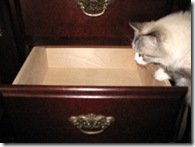
denisefisher said
Thanks for your vote of confidence. I can relate to your procrastination. Inertia is a powerful force.